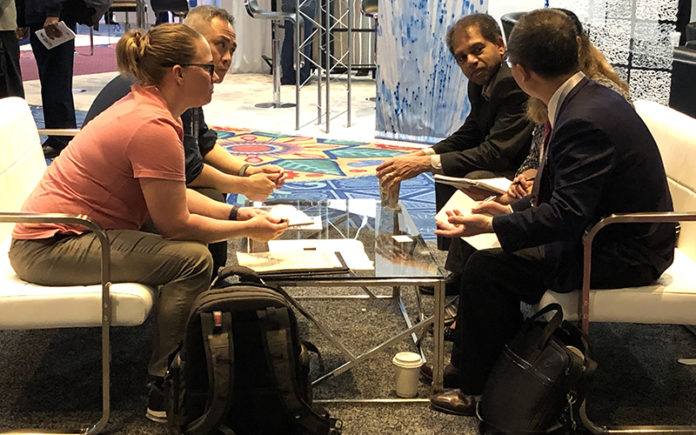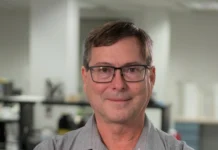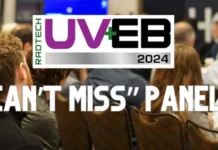By Dianna Brodine, managing editor
UV+EB Technology
A slightly smaller crowd led to deeper conversations among attendees, exhibitors and presenters at RadTech 2020 in Orlando, Florida. The event – held March 9-11 – was likely the last conference for attendees as concern over COVID-19 increased and subsequent industry events were canceled.
Despite the shadow, attendees filled conference rooms for presentations – some of which were given via video by those unable to travel. Panel discussions on the event floor also were busy, and the event exhibit floor – while quieter than usual – still saw significant traffic from interested and qualified attendee prospects.
Several awards were presented during the event. Thank you to Molly Hladik, chair of the Radtech Technical Committee, for sharing her comments from the RadTech and IUVA 2020 Awards Dinner, which became the basis for this report.
Best paper awards
Well over 100 abstracts were received, and all were thoroughly reviewed and discussed by the committee for inclusion in the RadTech 2020 Technical Programs. Committee members included Molly Hladik, Michelman; Julie Jessop, Mississippi State University; Joel Schall, Henkel; Alexander Polykarpov, Sirrus, Inc.; and Susan Bailey, Michelman.
Of the 100+ abstracts, more than 70 papers were submitted for review. From those 70+ papers, the technical committee reviewed and selected the best overall paper and the best student paper submitted for the conference. Unique to this year is that both papers awarded focused on the use of electron beam technology.
This year’s Best Paper designation was awarded to Sage Schissel and Karl Swanson for their paper titled, “Attainable Sustainable: Using Electron Beam Technology in Compostable Flexible Packaging.”
The Best Student Paper designation was awarded to Nicole Thiher, Erin Peters, Sage M. Schissel and Julie L.P. Jessop (faculty) for a paper titled, “Comparison of UV- and EB-Initiated Polymerizations Based on Equivalent Radical Concentration.”
Student poster competition
For the past few conferences, RadTech has partnered with the Technical Association for the Graphic Arts (TAGA) to request that graphic arts students compete in creating a poster to tout the benefits of energy curable technology. These posters then are voted on for the best representation of the technology. This year’s winner is an IUVA member: Dana Pousty is a student with the Water Research Center, School of Mechanical Engineering, Tel-Aviv University. The second-place winner is Prashant Koktar, a Ph.D. student in Paper and Printing Science at Western Michigan University, doing research in Industrial Inkjet Printing. These honorees will receive cash awards from RadTech International North America, and the first-place winner’s design will be featured on the cover of UV+EB Technology magazine.
Emerging technology awards
The emerging Technology Awards go to novel, creative and/or impactful uses of curing technologies. This year, the awards were given to a diverse group of end users. Winners included:
Electron Beam Technology for Food Packaging, PepsiCo
As innovative solutions are being sought for the development of a circular economy, PepsiCo is leading the way by working with the flexible packaging supply chain to develop advanced materials and processes for food packaging. As part of these PepsiCo initiatives, the company is exploring electron beam curing, as a fast, clean and energy-saving way to dry inks, coatings and adhesives for PepsiCo’s flexible packaging operations. Todd Fayne, a PepsiCo project management and execution specialist for packaging materials and processes, has engaged the electron beam community and RadTech, offering invaluable expertise and knowledge to assist the industry in advancing food packaging sustainability efforts.
Additive Manufacturing of High-Performance Material for Teeth Replacement, Myerson LLC
One of the largest and fastest-growing opportunities in additive manufacturing is the dental market. While the printing of teeth as temporary replacements is feasible, if not yet widely adopted, reaching the very high performance required for long-term tooth replacement has been out of reach. Myerson, LLC (Chicago, Illinois), in collaboration with Hybrid Ceramic (San Francisco, California), has developed a high-performance UV-curable dental material that can be printed and used as long-term teeth replacements. In vitro and in vivo trials are underway, with the goal to select the first-generation printers and begin the installation in dental laboratories and dental offices in 2020.
Surface Treatment of Intraocular Lens Injectors, AST Products, Inc.
LubriMATRIXTM technology has become a “Hidden Champion” for cataract surgery, providing a novel and innovative surface treatment technology specifically developed to enable a safer, simpler and more effective intraocular lens (IOL) delivery. An IOL is an artificial lens made of polymeric or silicone materials, and it is used to replace the patient’s natural lens that has become opaque, a.k.a. cataract. This technology is a patented surface treatment that utilizes an electron-beam-induced grafting method to append a hydrophilic layer onto the surface of an IOL. Since its commercialization, LubriMATRIXTM has increasingly gained market share in the nearly 30 million cataract surgeries worldwide annually, with EB helping to enable this vital process.
UV cured transparent films for Advanced Process Control (APC), Materials Business Unit, Applied Materials
The drive to smaller, faster and more versatile electronic devices such as cellphones has accelerated innovation in state-of-the-art computer chips. To support this innovation, Applied Materials has integrated a high-energy stationary UV cure system to fabricate the UV transparent polymer films. The optical uniformity of the film and time to cure makes UV curing a critical technology for these processes. Beyond semiconductor chip manufacturing, this method has a potential wide range of applications including device used for Augmented and Mixed Reality.
RadLaunch awards
Awards also were presented to students, universities, start-ups or others doing novel work in UV/EB curing.
HARP (High-Area Rapid Printing), Azul 3D
This three-year-old startup spun out of Northwestern University and is creating a paradigm shift in the plastics manufacturing sector via a revolutionary 3D-printing technology called HARP (High-Area Rapid Printing). HARP enables the use of both oxygen-sensitive and oxygen-insensitive photo-chemistries at rapid speeds broadening the scope of UV/EB technology for 3D printing.
A Solvent-Free Radical Photopolymerization that Continues its Extensive Post-Conversion in the Dark
A new photoinitiating system with unprecedented photo-efficiency and extensive post-conversion in the dark has been developed. This innovation allows reduced light exposure times helping to cure irregular surfaces, or thicker samples that might otherwise not work. This discovery promises to increase the scope of photocuring technologies into new application areas. This award goes to a team from the University of Colorado including Kangmin Kim, Jasmine Sinha, Charles Musgrave and Jeff Stansbury.
Next-Generation Energy Storage with UV Curing of Novel Polymer Electrolyte Materials, The Hosein Research Group, Syracuse University
The ever-increasing demand for Li-ion battery storage solutions soon will present an imminent crisis with the availability of mineral lithium to support the clean energy economy. The challenge with next-generation batteries is developing suitable electrolytes. To this end, polymer electrolytes are an attractive solution owing to their high conductivity, as well as mechanical and thermal conductivity. UV curing may be used to produce both acrylic- and epoxy-based polymer electrolytes, to effectively operate in prototype next-generation batteries.
Bio-based 1,5-Pentanediol: A New Renewable Monomer for the Radcure Industry, Pyran
The vast majority of chemicals are made from nonrenewable and often expensive petroleum (oil) resources. Pyran set out to find a better way and discovered a new pathway to make a chemical called 1,5-pentanediol (1,5-PDO) from renewable resources, such as corn cobs. This technology allows the renewable 1,5-PDO to be made at costs that can be 30-50% lower than that of similar oil-based chemicals. The 1,5-PDO product is a major component in many ultraviolet (UV) cure coatings.
Real-Time Feedback Controlled Monomer Conversion: A New Paradigm for UV Curing Process Control, Eindhoven University of Technology in The Netherlands
To prepare UV technology for the imminent fourth industrial revolution, a new paradigm is proposed for UV curing process control. The proposal consists of acquiring in-situ measurement data of monomer conversion from a spectrometer to compute a corrective action for the UV light source if needed. This innovation makes UV curing more robust to disturbances and may prove to be an indispensable solution for quality control.
A special RadLaunch University award was presented to Hamidreza Asemani and his professor advisor, Vijay Mannari, from the Coatings Research Institute at Eastern Michigan University for Novel UV-Initiated Dual-Curing Thermoset Materials Suitable for 3D Printing. While 3D-printing is fast emerging, one major challenge faced by 3D-printed products is their sub-optimum performance due to poor inter-layer adhesion. A team from Eastern Michigan University has designed a 3D printing material that cures by two independent cure mechanisms – one providing rapid green strength development for faster processing, while the second one allows for chemical bonding between the layers – thus significantly enhancing final product performance. The proposed system is enabled by UV curing technology, making it efficient and environmentally responsible.
More conference coverage will appear in Issue 2 of UV+EB Technology.






